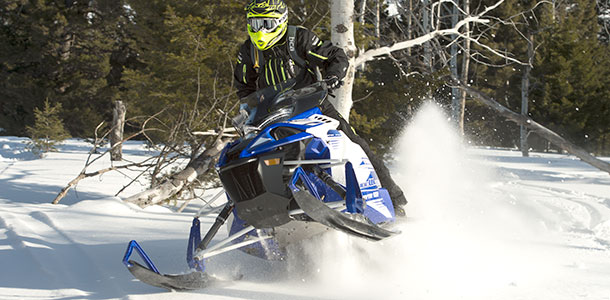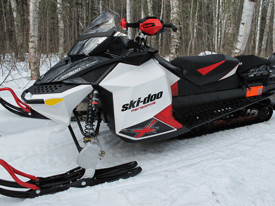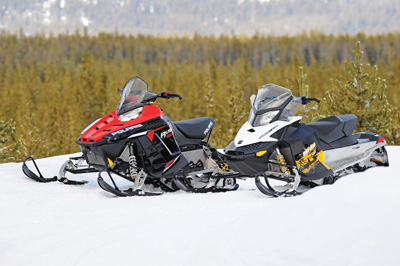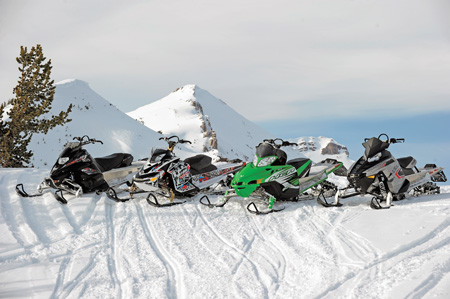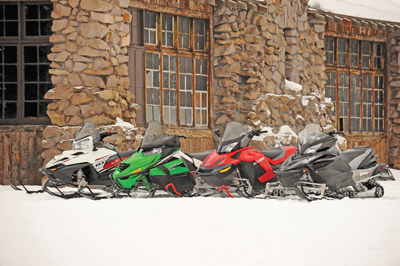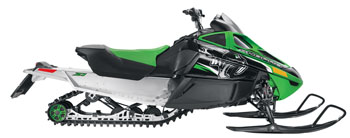 There’s an aura about crossover sleds that gets many snowmobilers excited. It’s the lure of being able to blaze down a groomed path and then, on a whim, head into the backcountry to search for an undiscovered hideaway.
There’s an aura about crossover sleds that gets many snowmobilers excited. It’s the lure of being able to blaze down a groomed path and then, on a whim, head into the backcountry to search for an undiscovered hideaway.
Also known as hybrids, they mostly appeal to “flatlanders,” snowmobilers who live in the Midwest, regions affected by lake-effect snowfall and remote parts in the eastern United States. These riders don’t have the massive tracts of land outside their doors that westerners enjoy, nor is the snow as deep or the terrain so extreme — but they have more trails! This is why a full-on mountain sled is too much, but a trail sled just isn’t enough.
Thank goodness for the two-stroke-powered, extreme backcountry sleds: the 2011 Arctic Cat Crossfire 8 Sno Pro; Ski-Doo Renegade Backcountry E-TEC 800R X and Polaris 800 Switchback Assault. They allow sledders to get out and explore what’s beyond the beaten path.
We took the three sleds out on our own adventure into the backcountry and on the trails near West Yellowstone, Montana, where we learned the highs and lows of these machines and figured out which kind of rider is best-suited for each sled.
2011 Polaris 800 Switchback Assault

The Polaris 800 Switchback Assault is all-new, and for that reason it’s the most interesting sled of the bunch. The front half is the Pro-Ride chassis that debuted last year on the 600 Rush. Unlike the Rush, the rear end has a full-length, traditional tunnel with an uncoupled skidframe wrapped in a 15- by 144- by 1.25-inch Camoplast Cobra track driven by the 800 Liberty Cleanfire powerplant. Polaris says the 800 Switchback Assault weighs 460 pounds.
2011 Polaris 800 Switchback Assault: On The Trail
Polaris engineers took steps to transform the Switchback Assault’s RMK DNA and tune it for the trail; most notably, the steering post. With the goal to make this sled get around a corner more easily, the sled uses the steering post from the Polaris Rush trail sled. Compared to the RMK’s post, the Switchback’s is mounted farther forward on the chassis and the driver’s hands move in more of an up-and-down (rather than forward/backward) plane through turns because the post angle is flatter. Footwells on the Switchback are also farther forward than the RMK. Tipped-up suspension rails effectively reduce the machine’s wheelbase.
The Polaris was speedy, interesting and fun on the trail. Speed is complements of the 800 Liberty engine that cranks out about 145 horses and responds quickly to input from the driver’s right thumb. The engine’s linear power curve delivers smooth, consistent acceleration from clutch engagement to the top end. Even though it’s “smooth,” the engine still delivers a low-end grunt that, with a quick whack of the throttle, can easily lighten the skis, making this a fun sled to leap off of a mogul or over slight rises and descents in the trail.
The sled is interesting because handling through turns requires drivers to be more “on cue” than they traditionally need to be when driving a Polaris. Riders will experience more inside ski lift through turns than the Cat or Ski-Doo. One tester said that he didn’t dare run the machine hard into a corner for fear of rolling over. The skis were slow to hook the snow and grab their line through corners, causing the sled to drift to the outside of the turns. A point-and-shoot driving style worked best. Our test sled had the accessory track with 2-inch lugs. The stock track has 1.25-inch lugs with 1.352-inch rubber fingers along the tips of the lugs.
Fortunately, for what the Switchback lacks in on-trail handling it regains some points for playfulness over bumps on the trail. The high fun factor is complements of the torquey engine and class-leading suspensions. With Walker Evans Needle shocks all the way around, the rider can hardly feel the sled set down again after soaring off a bump, especially up front. It feels solid and stable and even if the sled lands off-kilter, the suspension makes up for the driver’s miscue.
2011 Polaris 800 Switchback Assault: Off The Trail
Our test drivers unanimously agreed that the Polaris Switchback Assault is the preferred sled among these three for use off-trail. The Polaris was easiest to hold on its side when carving through powder, drivers could toss it around at will. It’s responsive to driver input, with gobs of traction in deep snow thanks to the accessory track.
The tall, Pro Taper handlebar is a nice feature that squares up the shoulders when standing. This sled doesn’t include a center grab strap. For a machine this well designed for boondocking, having to install it as an accessory is odd.
The Switchback has a modern look and feel with a comfortable handlebar height, lots of foot traction and excellent rider positioning off trail. Its tall rider position makes it easy to influence the vehicle’s route when horsing around off-trail, but this seems to contribute to its body roll, ski lift and push up front when on the trail blazing back to base camp. While the sled feels light, it carries itself bigger than the Cat and Doo.
Engine power is another thing that works well on this sled off trail. Low-end delivery is smooth and strong so a rider can modulate the throttle while sneaking through tight trees, but there’s also a strong “pop” available on cue to lighten the front end and get up and over a log or other obstacle.
2011 Arctic Cat Crossfire 8 Sno Pro

Arctic Cat’s Crossfire 8 Sno Pro is built on the M Series platform that debuted in 2005, for which Cat earned our Snowmobile of the Year award with the M7. The Crossfire Sno Pro has undergone a few major upgrades over the years, including the Suzuki H.O. 800 engine and new skis last year, and the Fox FLOAT rear suspension in 2009 as part of a 35-pound weight reduction that year. It has a 15- by 141- by 1.5-inch Camoplast Cobra track. Arctic Cat does not provide a weight figure for the Crossfire 8 Sno Pro.
2011 Arctic Cat Crossfire 8 Sno Pro: On The Trail
The Crossfire handles and carves nicely on the trail. The steering post angle, handlebar height (set to its lowest position) and plane of how the bar rotates as the driver steers through a turn makes him or her feel comfortable and sure of the sled.
The Crossfire’s M chassis is a traditional design where the driver sits farther back than the Ski-Doo or Polaris hybrid sleds. The old-style chassis feels like there’s a lot more machine out front than what a driver feels when driving the Renegade or Switchback. The Crossfire exhibits some inside ski lift, but it’s predictable and easy to manage. It definitely seems wide from the cockpit, with a bulbous windshield and old chassis that definitely feels dated, but it flat-out works for carving down a trail.
The seat is too low, making some drivers feel crouched, which is compounded by the ultra-shallow footwells. We’re OK with these wells on the M8 HCR, which has a taller seat so the knees are set closer to a 90-degree angle, but the Crossfire’s softer, thinner cushion gives the driver a cramped feeling that prevents locking in and connecting with the sled.
The 800cc Suzuki that powers the Crossfire is a lively and responsive engine. Now in its second year on the snow, we’ve grown more familiar with its performance, noting that it runs cleanly with quick throttle response and a steady pull out of corners. Arctic Cat rates the engine at 160 hp. This engine is a great runner, but the exhaust is loud and sounds unrefined.
Running down the trail over rollers and moderate bumps, the Crossfire feels stable and secure with good suspension calibrations, using Fox FLOAT 2 air shocks up front and on the rear torque arm, and a Fox Zero Pro coil-over front track shock. While the track is only 3 inches shorter than the Polaris, the rear end can’t handle a good thrashing over big bumps and holes as well as the Assault.
2011 Arctic Cat Crossfire 8 Sno Pro: Off The Trail
The Crossfire is easy to play with in the woods and meadows, and flotation from the 141-inch track is as good as the Polaris that has a 144-inch shoe. The engine revs quickly with great power and response so drivers can make quick, mid-line corrections through deep snow in tight quarters.
In powder, it’s playful and easy to lift a ski and carry it a long way with a simple punch on the throttle. The chassis is easily influenced by the driver when standing at the back of the tunnel so the sled can be railed around a curve on its side with the skis up and out of the snow.
Mountain ergos and Cat’s adjustable handlebars are a great benefit here. We rode the trails with the bar in the lowest setting and then raised it up when we reached off-trail play areas. With the handlebar up, it has great leverage to lay the sled on its side or lift a ski over brush and other obstacles. There is a significant difference in off-trail maneuverability between the low and high setting. The steering post and chassis feel like they have more flex than the Polaris or Ski-Doo, giving the machine a looser, less precise feel that drivers will notice on the trail, too.
Though the shallow footwells were a distraction on the trail, they didn’t even cross our minds in the backcountry. They put standing riders in a spot that balances the person’s weight so the driver and machine can work in unison.
2011 Ski-Doo Renegade E-Tec 800R Backcountry X

The Ski-Doo Renegade Backcountry X is more equipped for boondocking than its Renegade X stablemate. It has a lower gear ratio in the chaincase, a Summit-specific drive belt, wider skis — also from the Summit — and deeper track lugs (16- by 137- 1.75-inch). The E-TEC 800R engine spins it. Suspensions are upgraded, too, with HPG Plus R piggyback shocks with external rebound adjustment up front and a KYB Pro 36 rear track shock that has high- and low-speed compression adjustments. Ski-Doo lists the machine at 459 pounds.
2011 Ski-Doo Renegade E-Tec 800R Backcountry X: On The Trail
Even though the Renegade is marketed as a backcountry machine, it’s a better trail runner. Stability on the marked routes through the woods is a strong point of this sled as it was made from XP hardware that was, first and foremost, designed to go down the trail.
Ergonomics are one reason it stands out as a good trail sled. The driver can easily shift his or her weight from side to side and footwells put the rider’s feet out front to lock in place. The chassis is responsive to driver input, such as a firm tug on the inside handlebar that will hold the inside ski to the ground. Tall riders will like the 6-inch handlebar riser, but shorter people might not appreciate the longer reach up to the handlebar when leaning down and out for corners.
The E-TEC 800R truly is a remarkable two-stroke engine. It’s clean, precise and powerful, not to mention fuel economy is a few MPG better than other engines in the class. The sled accelerates hard out of corners, though it’s civilized. With the Backcountry X’s lower gearing it feels even more forceful than other E-TEC 800R models while winding out at a lower top speed.
In terms of steering the sled on the trail, it got mixed reviews. Two test riders said steering is heavy, but it needed more ski traction because it pushed. Another rider said it has great trail manners and it feels light. The difference in opinion comes from different riding styles among test drivers, and their preferences and tolerances for specific attributes.
2011 Ski-Doo Renegade E-Tec 800R Backcountry X: Off The Trail
With E-TEC direct injection hardware fastened to the cylinder head of the Rotax 800R engine, its low-speed vibration has been ironed out, giving smooth performance through the powerband. Engine harmonics usually cancel snowmobile engine vibration at more than 30 mph, but if you’re trying to creep through the trees at slow speeds it’s a different story. Fortunately, now with E-TEC the handlebar didn’t buzz while making our way through trees or trying to get smooth clutch engagement to preserve traction in uphill lines.
Ergonomics for goofing around in the woods suited our riders well; even our 5-foot, 9-inch test rider felt comfortable with the 6-inch tall handlebar riser, which is 1.5 inches taller than the Renegade X’s perch. This machine is the only one that has handguards, which not only help keep the hands warm, but deflect twigs and branches that off-trail riders are guaranteed to smack into. The center grab strap is flexible and easy to grab in an instant but lays out of the way so it doesn’t interfere when speeding down a twisty, hard-packed trail.
Despite the ergonomics, the Renegade was, by far, the most difficult of the three sleds to tip on its side in the powder; it wanted to plow instead of carve. Ski-Doo REV-based sleds suffered from this, too, and some folks have long blamed the front-end tub design of the REV chassis and its descendants for this, or perhaps the center of gravity is too low. We don’t know if that’s it, but the narrower ski-stance (to 37 inches from 40 inches in 2010) on 2011 Summits is a sign that Ski-Doo engineers are aware of the problem and trying to come up with a fix.

